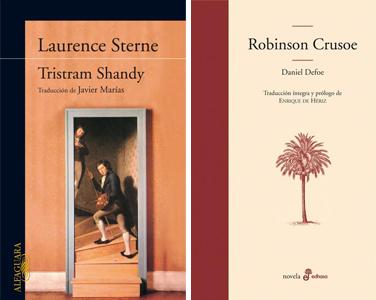Galdós produced a very disappointing translation of Dickens. Blasco Ibáñez plagiarised translations of Shakespeare. Some translators missed pages out of their translations and complete versions have only recently become available. And all of them, according to Eduardo Mendoza, are suffering from the same malady, the anger that takes over translators. It has only been a few years since decent translations by Spanish authors started to appear, Spanish authors lending their voices to English authors who they admired, or whose works inspired them.
It was Eduardo Mendoza who once said that “the most common characteristic of a translator is dissatisfaction. In fact, it is the profession with the highest percentage of bad-tempered people”. He went on to add that “a translation can only ever be worse than the original”. I don’t know if he was right, but I do know that, despite the general belief that it’s just about transferring the same ideas from one language into another, translation is an arduous task. It is a task that gets more and more complicated as you go along, when you find that there is no turning back.
Imagine that you’re immersed in a translation, one of a great and universally-acclaimed book that has already been translated more than once, when you come across a few pages which haven’t been translated. You realise that, if they were translated, it would make the book much better. The translator’s job here is also one of searching and investigating. They have to be alert to any change in the text, any alteration, absence or modification. It’s not surprising that you can lose your temper when you’re trying to find that word, that expression which would almost perfectly match what was said in the other language, and sometimes – most of the time – would say it much better. The task seems impossible, and that’s what resonates with me in Mendoza’s comment about literary translators.
I have read translations by authors whose original work, in Spanish, their native language, I have enjoyed, and I knew before I even started that I would also like these appropriated works, because I feel that any translation they do is also theirs in a way, another line to add to their bibliography.
Many of the familiar great authors have translated the works of writers they admired, and found that expressing their words was no mean feat. More than one of them failed, or failed to reach the high standards they expected of themselves. Perhaps this is because they were too young when they started translating, and had not yet acquired the skill that would later allow them to reach the heights of literary excellence – in their own words this time. Or perhaps it was simply not in their nature to be able to give voice to what another had so sublimely expressed.
Galdós produced a dreadful translation of Dickens’s The Pickwick Papers, despite the fact that he adored the novel. There are, apparently, various reasons why the translation was so bad, the main one being the young Galdós’ inexperience: he was a native of the Canary Islands, not very accomplished in the English language. Cortázar’s translation of Robinson Crusoe was not bad, but it did miss out a large chunk of the original, since that’s the text he had. He may have had a French copy, and so he produced the adventure novel that Spaniards know and love, as opposed to the great work of English literature whose message and reflections have more in common with philosophy. And Blasco Ibáñez, as has recently come to light, plagiarised part of the translation of Shakespeare which is usually attributed to him.
With all this in mind, it could be said that good, faithful translations of many great works of English literature have only started to appear relatively recently. Of course, language changes over time, and perhaps some of the best translations from the past now seem old-fashioned and in need of updating, although the real reason that new translations of the classics appear every so often is that the works have come out of copyright. That’s the moment when, once again, we can finally dig our teeth into a classic we have been dying to translate. Publishers and translators are desperately seeking the book that, relaunched, will be a great success. New covers, new prologues, new translators. As well as unknown professionals charged with giving voice to the text in a new language there are also, in some cases, professional authors who want to translate. The name of the translator now occupies a well-deserved place on the title page, alongside that of the author.
Among the first of those who come to mind when I think of author-translators is Javier Marías. It is always a pleasure to read him as a narrator, but as a translator, he is one of a kind. His Tristram Shandy is a gem, an exquisite delicacy that raises an already exalted classic to even greater heights. In 1979, it earned him the Spanish National Prize for Translation. He has also lent his voice to Joseph Conrad (The Mirror of the Sea), Thomas Hardy (The Withered Arm and other stories), Robert Louis Stevenson (De Vuelta del Mar or Home from the Sea, a selection of poems), Yeats (Celtic Twilight, which I particularly recommend), and Sir Thomas Browne, among others. And Marías himself considers his translations to be as much ‘his work’ as his novels are, because he puts so much of himself in there, as well as the original text. His early works show the obvious influence of his favourite authors, although even they are loaded with a distinctive style that unmistakably identifies their author, and which have caused him to be accused, in Spain, of being an Anglophile author, an insult that I believe is rather flattering.
Sometimes, his characters’ professions are directly related to translation or the interpretation of other people’s words and gestures, like the translator-protagonist of Corazón tan blanco (A Heart So White). At one point in this novel, we read that “nothing exists that is not spoken. And it is true that the only thing that we never translate is what is never spoken nor expressed.” These words remind me of what Antonio Muñoz Molina wrote about translation: “Learning the limits of what can be translated makes you more aware that there are limits to what words themselves can express.”
 How much of Laurence Sterne is there in Marías’ text? How much Fitzgerald in the first translation of This Side of Paradise, by Juan Benet? There is very little Dickens in Galdós, as far as we Spaniards can tell, but a fair amount of Galdós in Dickens – of Galdós as he was at twenty-something when youth fuelled his ambition to brilliantly express the great works of the English author he so admired.
How much of Laurence Sterne is there in Marías’ text? How much Fitzgerald in the first translation of This Side of Paradise, by Juan Benet? There is very little Dickens in Galdós, as far as we Spaniards can tell, but a fair amount of Galdós in Dickens – of Galdós as he was at twenty-something when youth fuelled his ambition to brilliantly express the great works of the English author he so admired.
Every period has certain words that are used for translation, and so we have many different translations of the same book, from different periods. It’s not exactly surprising, is it? That we want to update or adapt certain terms and expressions which have a certain old-fashioned, nineteenth-century feel to them when we are translating texts from the sixteenth century. Mondadori recently published a new Spanish edition of the complete works of Shakespeare in a bid to do just that: to modernise the language, bringing it into the 21st century in a way that, without losing the rhythm and style of the original, would make it easier for us Spanish speakers to understand the subtleties of a work so rich in nuances and twists.
Perhaps the answer to what there is of the author-translator in these texts is revealed in what Marías said about the influence of certain authors on his early work: this trace of imitation that reveals his influences and his fascination with having an author as a ‘source’ to drink in and emulate almost unconsciously in his writing. Maybe there is something of this but, in an author’s translation of a text, it is reversed; he leaves a mark of his own style, the inevitable footprint that reveals his presence. I have no doubt about that. I have read translations by authors whose original work, in Spanish, their native language, I have enjoyed, and I knew before I even started that I would also like these appropriated works, because I feel that any translation they do is also theirs in a way, another line to add to their bibliography.
Writers reinvent the world when they write, they say things in another way, things that move us all, they analyse universal feelings, they describe situations that we’ve all experienced at one time or another, and it is therefore inevitable that they pass their vision of the world on to their translations.
Writers reinvent the world when they write, they say things in another way, things that move us all, they analyse universal feelings, they describe situations that we’ve all experienced at one time or another, and it is therefore inevitable that they pass their vision of the world on to their translations. They are not mindless tools, working objectively. First and foremost, because they are human beings and not computers programmed to memorize however many words and how to say them in another language. Secondly, because they are never innocent. There is no innocence in translation, just as there is no innocence in any creative exploit. You are transforming and explaining someone else’s words, saying them for the first time – this is what the translator believes, what they have to believe. That is how creators work, and so it is not surprising that the results can be great works, sometimes much better than the original.
Who are we really admiring when we read Cortázar’s translation of Poe; Poe himself, or the translator? I think that in part we read – and buy – translations by a well-known author for the excitement of finding a trace of them hidden amongst the letters of some translated sentence of another great author’s work. This is where the greatest pleasure of translation can be found and I believe that, even if I were to learn to read perfectly in English, and could therefore appreciate the author’s talent in their original language, I would not abandon the translations by the beloved Spanish authors who dared to take on the challenge of translating Byron’s letters (as Eduardo Mendoza did), or the extended version of Robinson Crusoe as translated by Enrique De Hériz (which includes the pages missing from Cortázar’s 1944 edition). If just a small trace of them is left behind in the classic, I’m happy. And something always is left behind, just try to prove me wrong.
[su_note note_color=”#eaeae9″]Translated by Alison Walsh & Ben Ffrancon Davies[/su_note]

